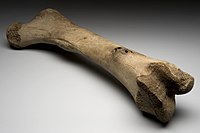
Photo from wikipedia
The formation of the mandibular condylar cartilage (MCC) and its subchondral bone is an important but understudied topic in dental research. The current concept regarding endochondral bone formation postulates that… Click to show full abstract
The formation of the mandibular condylar cartilage (MCC) and its subchondral bone is an important but understudied topic in dental research. The current concept regarding endochondral bone formation postulates that most hypertrophic chondrocytes undergo programmed cell death prior to bone formation. Under this paradigm, the MCC and its underlying bone are thought to result from 2 closely linked but separate processes: chondrogenesis and osteogenesis. However, recent investigations using cell lineage tracing techniques have demonstrated that many, perhaps the majority, of bone cells are derived via direct transformation from chondrocytes. In this review, the authors will briefly discuss the history of this idea and describe recent studies that clearly demonstrate that the direct transformation of chondrocytes into bone cells is common in both long bone and mandibular condyle development and during bone fracture repair. The authors will also provide new evidence of a distinct difference in ossification orientation in the condylar ramus (1 ossification center) versus long bone ossification formation (2 ossification centers). Based on our recent findings and those of other laboratories, we propose a new model that contrasts the mode of bone formation in much of the mandibular ramus (chondrocyte-derived) with intramembranous bone formation of the mandibular body (non-chondrocyte-derived).
Journal Title: Journal of Dental Research
Year Published: 2017
Link to full text (if available)
Share on Social Media: Sign Up to like & get
recommendations!